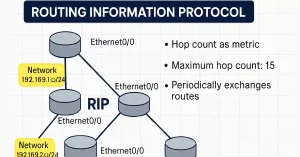How to Configure Routing Information Protocol (RIP)
Routing Information Protocol (RIP) is a dynamic routing protocol that defines a way for routers to connect different networks using the Internet Protocol (IP) to share information about how to route traffic among these other networks. The Routing Information Protocol (RIP) uses hop count as a routing metric to determine the best path between the source and […]

